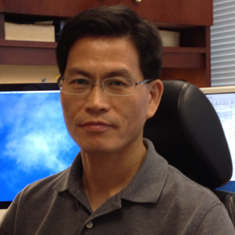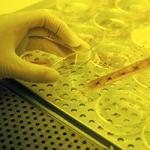
Research Topics
Life is established through varying degrees of hierarchical self-organization, from individual molecules and complexes to higher-order macromolecular assemblies. Understanding how cells orchestrate these diverse structural entities to induce a specific biological function is a key step to understanding the mystery of life. We have established an interdisciplinary research program aimed at addressing two fundamental questions:
- How are higher-order macromolecular assemblies generated?
- How are they further organized into a macroscale subcellular architecture to lay the foundations for inducing discrete intracellular processes?
The centrosome, which plays a central role as the main microtubule-organizing center for animal cell division, appears to be a particularly attractive model system for studying the formation of higher-order architectures thanks to the presence of multiple scaffold proteins that are concentrically arranged around a centriole in a highly ordered manner. For the past few years, we have been investigating the structure and function of several pericentriolar scaffolds, such as Cep192, Cep152, and Cep63, along with its effector, Polo-like kinase 4 (Plk4), a key regulator for centriole duplication. Our multifaceted approach has brought together wide-ranging fields, including cell biology (e.g., super-resolution microscopy, atomic force microscopy), biophysical chemistry (e.g., analytical ultracentrifugation, circular dichroism, SEC-MALS), structural biology (e.g., X-ray crystallography, NMR spectroscopy, SAXS), electron microscopy (e.g., thin-section TEM, cryo-EM), and nanomaterials science (e.g., nanopillar technology).
Our experience has been enriched by working effectively with supramolecular architectures generated through intricately regulated physicochemical processes. Our long-term goal is to understand the organization and function of the centrosome as a holistic functional entity. This research may offer a new paradigm for investigating the ways in which macroscale supramolecular assemblies are architected to achieve a new level of functional proficiencies, and it may provide a potential roadmap for studying other biological processes orchestrated by higher-order subcellular structures.
Biography
Dr. Kyung Lee received his Ph.D. in 1994 from the Department of Biochemistry at Johns Hopkins University in Baltimore. He then worked with Dr. Raymond Erikson at Harvard University as a postdoctoral fellow studying protein kinase and cancer. In 1998, he joined NIH as a tenure-track investigator in the Laboratory of Metabolism at NCI. In 2005, Dr. Lee became a senior investigator and head of the Chemistry Section, Laboratory of Metabolism.
Dr. Lee is the recipient of an NCI Intramural Research Award, a Society for Biomedical Research CKD Award, an NCI CCR Synergy Award, and several Federal Technology Transfer Awards for his inventions and patents related to Plk1. He serves as an academic editor for PLoS ONE and an editorial board member for The Journal of Biological Chemistry.
Selected Publications
- Park SY, Park JE, Kim TS, Kim JH, Kwak MJ, Ku B, Tian L, Murugan RN, Ahn M, Komiya S, Hojo H, Kim NH, Kim BY, Bang JK, Erikson RL, Lee KW, Kim SJ, Oh BH, Yang W, Lee KS. Molecular basis for unidirectional scaffold switching of human Plk4 in centriole biogenesis. Nat Struct Mol Biol. 2014;21(8):696-703.
- Liu F, Park JE, Qian WJ, Lim D, Gräber M, Berg T, Yaffe MB, Lee KS, Burke TR Jr. Serendipitous alkylation of a Plk1 ligand uncovers a new binding channel. Nat Chem Biol. 2011;7(9):595-601.
- Soung NK, Park JE, Yu LR, Lee KH, Lee JM, Bang JK, Veenstra TD, Rhee K, Lee KS. Plk1-dependent and -independent roles of an ODF2 splice variant, hCenexin1, at the centrosome of somatic cells. Dev Cell. 2009;16(4):539-50.
- Yun SM, Moulaei T, Lim D, Bang JK, Park JE, Shenoy SR, Liu F, Kang YH, Liao C, Soung NK, Lee S, Yoon DY, Lim Y, Lee DH, Otaka A, Appella E, McMahon JB, Nicklaus MC, Burke TR Jr, Yaffe MB, Wlodawer A, Lee KS. Structural and functional analyses of minimal phosphopeptides targeting the polo-box domain of polo-like kinase 1. Nat Struct Mol Biol. 2009;16(8):876-82.
- Kang YH, Park JE, Yu LR, Soung NK, Yun SM, Bang JK, Seong YS, Yu H, Garfield S, Veenstra TD, Lee KS. Self-regulated Plk1 recruitment to kinetochores by the Plk1-PBIP1 interaction is critical for proper chromosome segregation. Mol Cell. 2006;24(3):409-22.
Related Scientific Focus Areas




Molecular Biology and Biochemistry
View additional Principal Investigators in Molecular Biology and Biochemistry

This page was last updated on Wednesday, April 10, 2024